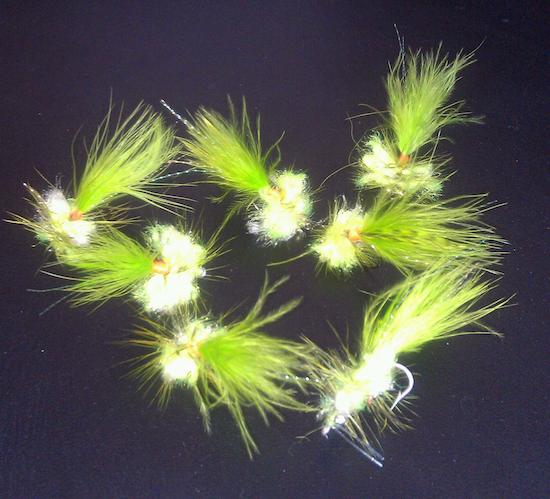The Peruke Fly
Guest Blog by David Caprera

American model and television host Michele Merkin. She has nothing whatsoever to do with the blog post. (Photo credit: Wikipedia)
I have come up with a name for my Mosquito Lagoon redfish fly that is a cross between a wooly bugger and a merkin. I am calling it a “peruke.” If you are familiar with the origin of the name “merkin” for Del Brown’s crab fly, you will appreciate the name “peruke.” If you would like to learn more about a merkin, see http://en.wikipedia.org/wiki/Merkin.
The “Peruke”
Size 4 stainless hook
Tail: Chartreuse marabou, “long and flowing”, four strands of crystal flash.
Butt: Orange dubbing. Purple optional. (If you examine a fiddler crab, it has an orange fiddle, sometimes with a touch of purple)
Body: Chartreuse and white yarn tied like a merkin
Legs: A large barred chartreuse hackle is wrapped through the body (the wooly bugger part) from rear to front.
Eyes: Extra small lead eyes, tied on the bottom.
Weed guard: Mono.
The combination of little weight, marabou and the hackle wrap makes the fly easy to cast and allows it to land very soft. The reds in shallow water just don’t seem to like the splash of heavier flies.
From the internet:
“The peruke’s story begins like many others—with syphilis. By 1580, the STD had become the worst epidemic to strike Europe since the Black Death. According to William Clowes, an “infinite multitude” of syphilis patients clogged London’s hospitals, and more filtered in each day. Without antibiotics, victims faced the full brunt of the disease: open sores, nasty rashes, blindness, dementia, and patchy hair loss. Baldness swept the land.
At the time, hair loss was a one-way ticket to public embarrassment. Long hair was a trendy status symbol, and a bald dome could stain any reputation. When Samuel Pepys’s brother acquired syphilis, the diarist wrote, “If [my brother] lives, he will not be able to show his head—which will be a very great shame to me.” Hair was that big of a deal. And so, the syphilis outbreak sparked a surge in wig making. Victims hid their baldness, as well as the bloody sores that scoured their faces, with wigs made of horse, goat, or human hair.”
The long haired wig was called a “peruke.” From the French “perruque” meaning wig.
David Caprera divides his time between Denver and New Smyrna Beach. He guests blogs for the Spotted Tail as the whim strikes him.
All content in this blog, including writing and photos, copyright John Kumiski 2014. All rights are reserved.

Speak Your Mind